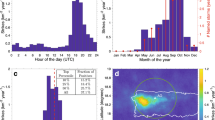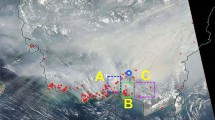Abstract
Stratospheric ozone attenuates harmful ultraviolet radiation and protects the Earth’s biosphere1. Ozone is also of fundamental importance for the chemistry of the lowermost part of the atmosphere, the troposphere1,2,3,4,5,6,7,8. At ground level, ozone is an important by-product of anthropogenic pollution7, damaging forests and crops5,6, and negatively affecting human health9. Ozone is critical to the chemical and thermal balance of the troposphere10 because, via the formation of hydroxyl radicals, it controls the capacity of tropospheric air to oxidize and remove other pollutants1. Moreover, ozone is an important greenhouse gas, particularly in the upper troposphere1. Although photochemistry in the lower troposphere is the major source of tropospheric ozone2,7,11, the stratosphere–troposphere transport of ozone12,13,14,15,16,17,18,19 is important to the overall climatology, budget and long-term trends of tropospheric ozone3,4,8,12. Stratospheric intrusion events, however, are still poorly understood. Here we introduce the use of modern windprofiler radars20,21,22 to assist in such transport investigations. By hourly monitoring the radar-derived tropopause height23,24,25 in combination with a series of frequent ozonesonde balloon launches, we find numerous intrusions of ozone from the stratosphere into the troposphere in southeastern Canada. On some occasions, ozone is dispersed at altitudes of two to four kilometres, but on other occasions it reaches the ground, where it can dominate the ozone density variability. We observe rapid changes in radar tropopause height immediately preceding these intrusion events. Such changes therefore serve as a valuable diagnostic for the occurrence of ozone intrusion events. Our studies emphasize the impact that stratospheric ozone can have on tropospheric ozone, and show that windprofiler data can be used to infer the possibility of ozone intrusions, as well as better represent tropopause motions in association with stratosphere–troposphere transport.
This is a preview of subscription content, access via your institution
Access options
Subscribe to this journal
Receive 51 print issues and online access
$199.00 per year
only $3.90 per issue
Buy this article
- Purchase on Springer Link
- Instant access to full article PDF
Prices may be subject to local taxes which are calculated during checkout




Similar content being viewed by others
References
World Meteorological Organization. Scientific Assessment of Ozone Depletion 1998. Global Ozone Research Monitoring Project Report 44 (WMO, Geneva, 1999)
Altshuller, A. P. & Lefohn, A. S. Background ozone in the planetary boundary layer over the United States. J. Air Waste Manage. Assoc. 46, 134–141 (1996)
Lin, C.-Y. C., Jacob, D. J., Munger, J. W. & Fiore, A. M. Increasing background ozone in surface air over the United States. Geophys. Res. Lett. 27, 3465–3468 (2000)
Naja, M., Akimoto, H. & Staehelin, J. Ozone in background and photochemically aged air over central Europe: analysis of long-term ozonesonde data from Hohenpeissenberg and Payerne. J. Geophys. Res. 108 (D2). 4063 doi: 10.1029/2002JD002477 (2003)
Ashmore, M. R. Assessing the future global impacts of ozone on vegetation. Plant Cell Environ. 28, 949–964 (2005)
Wang, X. & Mauzerall, D. L. Characterizing distributions of surface ozone and its impact on grain production in China, Japan and South Korea: 1900 and 2020. Atmos. Environ. 38, 4383–4402 (2004)
Hogrefe, C. et al. Simulating changes in regional air pollution over the eastern United States due to changes in global and regional climate and emissions. J. Geophys. Res. 109 D22301 doi: 10.1029/2004JD004690 (2004)
Stevenson, D. S. et al. Multimodel ensemble simulations of present-day and near future tropospheric ozone. J. Geophys. Res. 111 doi: 10.1029/2005JD006338 (2006)
World Health Organization (WHO). Health Aspects of Air Pollution with Particulate Matter, Ozone And Nitrogen Dioxide. Report EUR/03/5042688 on a WHO working group (WHO Regional Office for Europe, Copenhagen, 2003); 〈http://www.euro.who.int/document/e79097.pdf〉
Lelieveld, J. & Dentener, F. J. What controls tropospheric ozone? J. Geophys. Res. 105 (D3). 3531–3552 (2000)
Hirsch, A. I., Munger, J. W., Jacob, D. J., Horowitz, L. W. & Goldstein, A. H. Seasonal variation of the ozone production efficiency per unit NOx at Harvard Forest, Massachusetts. J. Geophys. Res. 101, 12659–12666 (1996)
Tarasick, D. W., Fioletov, V. E., Wardle, D. I., Kerr, J. B. & Davies, J. Changes in the vertical distribution of ozone over Canada from ozonesondes: 1980–2001. J. Geophys. Res. 110 doi: 10.1029/2004JD004643 (2005)
Holton, J. R. et al. Stratosphere-troposphere exchange. Rev. Geophys. 33, 403–439 (1995)
Stohl, A. et al. A new perspective on stratosphere-troposphere exchange. Bull. Am. Meteorol. Soc. 84, 1565–1573 (2003)
Stohl, A. et al. The influence of stratospheric intrusions on alpine ozone concentrations. Atmos. Environ. 34, 1323–1354 (2000)
Beekmann, M. et al. Regional and global tropopause fold occurence and related ozone flux across the tropopause. J. Atmos. Chem. 28, 29–44 (1997)
Sprenger, M., Croci Maspoli, M. & Wernli, H. Tropopause folds and cross-tropopause exchange: A global investigation based upon ECMWF analyses for the time period March 2000 to February 2001. J. Geophys. Res. 108 (D12). 8518 doi: 10.1029/2002JD002587 (2003)
Wernli, H. & Bourqui, M. A Lagrangian 1-year climatology of (deep) cross-tropopause exchange in the extratropical Northern Hemisphere. J. Geophys. Res. 107 (D2). 4021 doi: 10.1029/2001JD000812 (2002)
Cooper, O. R. et al. Large upper tropospheric ozone enhancements above mid-latitude North America during summer: In situ evidence from the IONS and MOZAIC ozone monitoring network. J. Geophys. Res. 111 D24S05 doi: 10.1029/2006JD007306 (2006)
Roettger, J. & Larsen, M. F. in Radar in Meteorology (ed. Atlas, D.) 235–281 (American Meteorology Society, Boston, Massachusetts, 1990)
Gage, K. S. in Radar in Meteorology (ed. Atlas, D.) 534–565 (American Meteorology Society, Boston, Massachusetts, 1990)
Hocking, W. K. Recent advances in radar instrumentation and techniques for studies of the mesosphere, stratosphere and troposphere. Radio Sci. 32, 2241–2270 (1997)
Larsen, M. F. & Röttger, J. VHF and UHF Doppler radars as tools for synoptic research. Bull. Am. Meteorol. Soc. 63, 996–1008 (1982)
Hocking, W. K., Ruester, R. & Czechowsky, P. Absolute reflectivities and aspect sensitivities of VHF radio wave scatterers measured with the SOUSY radar. J. Atmos. Terr. Phys 48, 131–144 (1986)
Gage, K. S. & Green, J. L. An objective technique for the determination of tropopause height from VHF radar observations. J. Appl. Meteorol. 21, 1150–1154 (1982)
Stohl, A., Forster, C., Frank, A., Seibert, P. & Wotawa, G. Technical note: The Lagrangian particle dispersion model FLEXPART version 6.2. Atmos. Chem. Phys. 5, 2461–2474 (2005)
Stohl, A., Hittenberger, M. & Wotawa, G. Validation of the Lagrangian particle dispersion model FLEXPART against large scale tracer experiment data. Atmos. Environ. 24, 4245–4264 (1998)
Stohl, A. et al. A replacement for simple back trajectory calculation in the interpretation of atmospheric trace substance measurements. Atmos. Environ. 36, 4635–4648 (2002)
Forster, C. et al. Lagrangian transport model forecasts and a transport climatology for the Intercontinental Transport and Chemical Transformation 2002 (ITCT 2K2) measurement campaign. J. Geophys. Res. 109 D07S92 doi: 10.1029/2003JD003589 (2004)
Coté, J. et al. The operational CMC/MRB Global Environmental Multiscale (GEM) model. Part 1: design considerations and formulation. Mon. Weath. Rev. 126, 1373–1395 (1998)
Acknowledgements
This work was funded primarily by the Canadian Foundation for Climate and Atmospheric Science, and by the Natural Sciences and Engineering Research Council of Canada. We are grateful for logistical and financial support provided by Environment Canada. The McGill and Walsingham radars were installed with support from the Canada Innovation Foundation and Ontario Innovation Trust. Technical support was provided by G. Carey-Smith, J. Davies, T. Officer, M. van der Zanden and R. van der Zanden. We thank the CSA staff for making facilities at the Canadian Space Agency in Montreal available to us. Assistance and advice regarding the FLEXPART model was provided by O. Cooper, and advice and guidance from W. Komhyr at EN-SCI Corporation was also appreciated.
Author Contributions W.K.H. designed and built all the windprofiler radars used in the studies, and wrote all the on-line radar analysis software. He also originally proposed the concept of using the radars and ozone studies together to investigate stratosphere–troposphere transport, wrote the original proposal, and was the principal investigator on the grant used to obtain the data. T.C.-S. was a post-doctoral fellow on the project, and was responsible for all ozonesonde launches in regard to planning and implementation. He was also responsible for adaptation and implementation of the Flexpart model, and was responsible for data analysis after each flight. D.W.T. was the most experienced of the team in regard to ozone science, and was responsible for the direct supervision of T.C.-S. for significant parts of his tenure. He provided advice about ozonesonde launches and data interpretation, including initiating the use of FLEXPART and GEM to provide a four-dimensional view of the intrusion processes. P.S.A. is a research scientist who co-managed the ozonesonde programme, undertook much of the pre-campaign preparation work, and provided scientific direction during the experimental campaigns. K.S. operated the Toronto Atmospheric Observatory, which was used as a support facility to provide back-up data about the behaviour of various atmospheric chemical constituents. Y.R. supported T.C.-S. with advice. I.Z. and P.A.T., as principal investigators of various windprofiler projects, were responsible for the day-to-day running of the radars.
Author information
Authors and Affiliations
Corresponding author
Ethics declarations
Competing interests
The authors declare no competing financial interests.
Supplementary information
Supplementary Information
The file contains Supplementary Methods, Supplementary Table 1 and Supplementary Figure 5 (PDF 77 kb)
Rights and permissions
About this article
Cite this article
Hocking, W., Carey-Smith, T., Tarasick, D. et al. Detection of stratospheric ozone intrusions by windprofiler radars. Nature 450, 281–284 (2007). https://doi.org/10.1038/nature06312
Received:
Accepted:
Issue Date:
DOI: https://doi.org/10.1038/nature06312
This article is cited by
-
Atmospheric dynamics impact on urban-ozone variability over the Indo-Gangetic Plain under very low anthropogenic emission
International Journal of Environmental Science and Technology (2023)
-
Observation of stratosphere–troposphere exchange during a pre-monsoon thunderstorm activity over Kochi, India
Meteorology and Atmospheric Physics (2022)
-
Evaluation of Inter-Hemispheric Characteristics of the Tropopause–Stratopause–Mesopause Over Sub-Tropical Regions
Pure and Applied Geophysics (2018)
-
Observation of a summer tropopause fold by ozonesonde at Changchun, China: Comparison with reanalysis and model simulation
Advances in Atmospheric Sciences (2015)
-
Four-year measurements of trace gases (SO2, NOx, CO, and O3) at an urban location, Kanpur, in Northern India
Journal of Atmospheric Chemistry (2014)
Comments
By submitting a comment you agree to abide by our Terms and Community Guidelines. If you find something abusive or that does not comply with our terms or guidelines please flag it as inappropriate.



